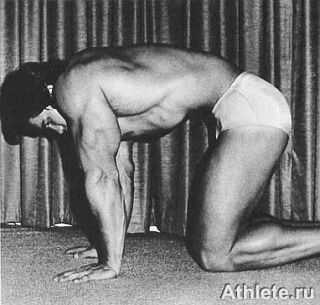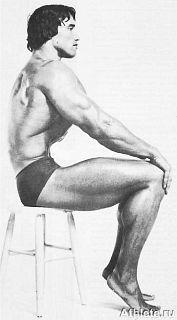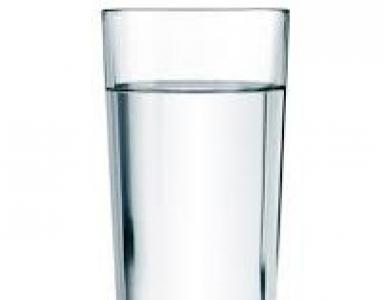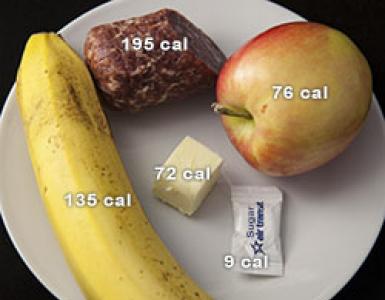Method of development of abdominal muscles. Exercise the abdominal press for relief
Twisting with the use of weights on elongated arms
This exercise is aimed at strengthening the upper abdominal muscles. Lie on your back, knees bent, heels on the floor. Take in the hands of light dumbbells and extend the straight arms behind the head. And now, do twists without bending your hands. Do not push with just your hands. Do 12-15 repetitions.
Twisting for abdominal sitting
Sit on the edge of the bench. Grasp its edge and slightly bend back, straighten your legs, feet 10-15 cm from the floor. Bend your legs and slowly raise your knees to your chest. At the same time, tilt the body forward so that the hips are pressed against the chest. Return to the starting position. Carry out an approach of 12 reps.

Exercise "corkscrew"
This exercise is aimed at both the lower and oblique abdominal muscles. Lie on your back, raise your legs strictly vertically. Knees should be slightly bent. Hands lie along the body with the palms facing down. Use the bottom press to tear your hips off the floor, and tilt your legs to your chest, lifting your feet straight up. At the same time, turn the hips to the right. Lock in this position, then return to the starting position. Repeat the motion by turning left. Perform 10 repetitions on each side.
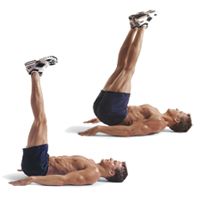
One-sided twisting using weigher
This exercise is aimed at both the upper and the oblique abdominal muscles. Lie on your back, legs bent, feet on the floor. Take the dumbbell with both hands and press it to the right shoulder. Lift the housing and turn it to the left. Go down on your back, then repeat the exercise on the other side, pressing the dumbbell to your left shoulder. Do 3 sets of 8 reps on each side.

Twisting on the knees with the pull of the upper block
Kneel to the block and grab the ends of the rope attached to the high block. Hands are located on the sides of the face. Tilt the body forward. Return to the starting position, then repeat the movement, this time leaning towards the left knee. Return to the starting position, then bend to the right knee. This is one repetition. Do 3 sets of 8 reps.

Combination of twists and lateral slopes
This exercise is aimed at both the upper and the oblique abdominal muscles. Lying on his back, knees bent, feet on the floor, hands behind his head. Tear off the scapula from the floor and bend forward. Then turn the body to the left, move the left armpit towards the left thigh. Straighten, then turn to the right. Go back to the starting position and repeat the movement. Do 3 sets of 8 reps on each side.
: Development of the upper section of the rectus abdominis muscles.
Performance: (1) Lay your back on the floor and put your feet on the bench in front of you, bending them in your lap. You can lay your hands behind your head or hold them in front of your body, as convenient. (2) Bend the trunk towards the knees, arching his back. Do not try to tear the entire back off the floor, just lean forward and bring the chest to the pelvic area. At the top of the movement, specifically tighten the abdominal muscles to achieve a complete contraction, then relax and lower to the starting position. This movement should be carried out slowly, under full control.
You can change the angle of the load on the abdominal muscles, changing the height of the bench. Instead of a bench, try to rest your feet on the wall at any height that you find convenient for yourself.
LIFTING HULLS WITH TURN
Purpose of the exercise: Development of the upper abdominal and oblique muscles of the abdomen.
Performance: (1) Lay your back on the floor and put your feet on the bench in front of you, bending them in your lap. (2) Place your hands behind your head and bend your body toward your knees, arching your back. In this case, bend the trunk sideways, so that your right elbow goes to the left knee. Relax and return to the starting position. Then repeat the motion with a twisting in the opposite direction, so that the left elbow goes to the right knee. Continue to alternate the movement until the end of the series.
STRINGS ON THE ROME CHAIR
 Purpose of the exercise: Accents the load on the upper rectus abdominal muscles.
Purpose of the exercise: Accents the load on the upper rectus abdominal muscles.
Performance: (1) Sit on the Roman bench, get your feet under the prop and fold your arms in front of you. (2) While holding the belly retracted, descend at an angle of approximately 70 °, but not parallel to the floor. Rise to the starting position and bend the trunk forward as far as possible, feeling the contraction of the rectus abdominis muscles.
You can experiment by raising the front of the Roman bench to create a slope and increase the intensity of the exercise. This exercise can also be performed with variable resistance, if you start on an elevated bench, and then, when you start to get tired, lower it to the floor and continue the series.
FEEDBACKS
 Purpose of the exercise:
Purpose of the exercise:
Performance: This exercise is best performed on a bench for bench presses, with a stand at one end. (1) Lay your back on the bench, pull your hands back and grasp the bar or the edge of the bench for balance. Bend your knees and raise them as high as possible, without tearing the pelvic area and lower back from the bench. (2) From this position, raise your knees even higher and pull them as close as possible to your face, arching your back and bringing the pelvic area closer to your chest. Hold for a second at the end of the movement and specifically strain the abdominal muscles to achieve their full contraction. Slowly lower your knees until the coccyx touches the bench (do not lower your legs, otherwise the exercise will turn into a kind of lifting of the legs). Repeat this movement slowly and under full control.
FEEDBACKS ON THE TOURNAMENT
 Purpose of the exercise: Development of the lower abdominal press.
Purpose of the exercise: Development of the lower abdominal press.
Performance: This is another version of the reverse bend of the trunk, only, instead of lying on the bench, you hang on the crossbar. (1) Hang on the crossbar and raise the knees to the level of the abdomen so that the hips are parallel to the floor. (2) From this position, pull your knees to the chin, arching your back and trying to "roll into the ball." Hold for a second at the top of the movement and strain the abdominal muscles as much as possible to achieve full contraction, then lower your knees to the starting position without straightening your legs.
Many ordinary people, most bodybuilders (because of the large mass of the hips) can not correctly perform the back bend of the trunk on the crossbar. There is an easier option when you lie your head up on an incline bench. This creates a greater load than with the reverse bending of the trunk on a horizontal bench, but you can vary it at will by changing the angle of the bench.
KNIGHT LEGS ON THE VERTICAL BENCH
![]() Purpose of the exercise: Development of the lower abdominal press.
Purpose of the exercise: Development of the lower abdominal press.
Performance: This is a variant of the back bend of the trunk on the crossbar. (1) Instead of the crossbar, sit on a vertical bench with an elbow support and raise the knees to the level of the abdomen so that the hips are parallel to the floor. (2) From this position, pull your knees up as high as possible to the chin, arching your back and trying to "roll into the ball." At the top of the movement, hold for a second and strain the abdominal muscles to achieve their full contraction. Then lower your legs to their original position, but do not straighten your knees.
STRINGS ON UPPER BLOCK
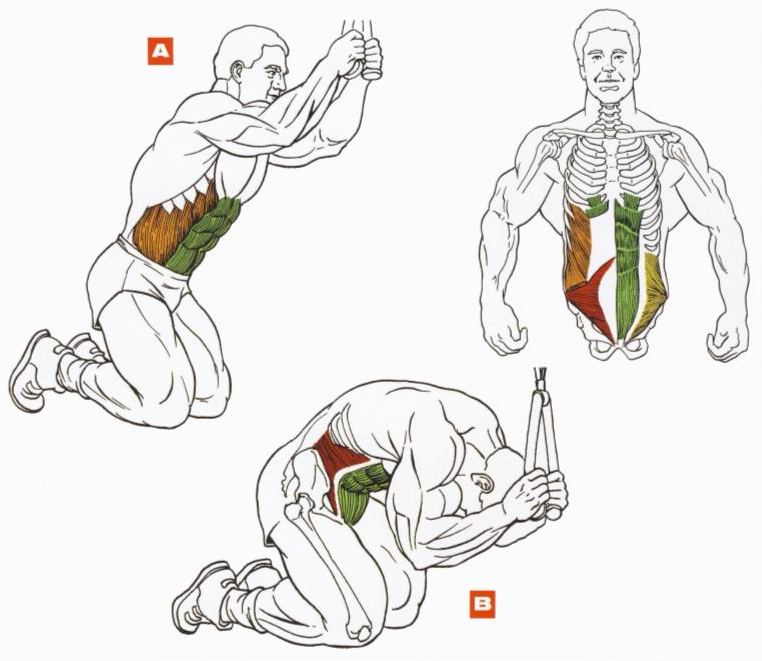 Purpose of the exercise: Development of the upper and lower abdominal press. This exercise was used more often in the old days than now, but it is quite effective.
Purpose of the exercise: Development of the upper and lower abdominal press. This exercise was used more often in the old days than now, but it is quite effective.
Performance: (1) Attach the rope to the top block. Go down on your knees and grasp the rope with both hands. (2) Holding the rope in front of you at the level of your forehead, lean forward, arching your back and bringing your head closer to your knees. Hold for a second at the bottom of the movement to achieve complete contraction of the abdominal muscles, then return to the starting position. Do not pull with your hands; The main load should lie on the abdominal muscles.
LIFTING OF THE CASING ON THE SIMULATOR
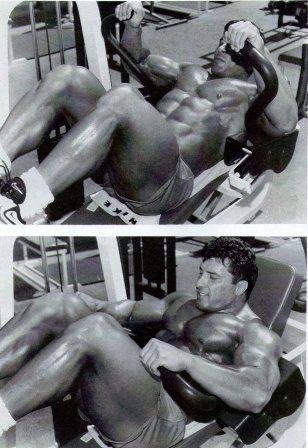 Purpose of the exercise:
Purpose of the exercise:
Performance: A significant majority of bodybuilders believe that when training abdominal muscles there is no need for simulators, but others are ready to swear that the simulators are very useful. In any case, focus on the convergence of the pelvic region and chest, feeling an intensive contraction of the abdominal muscles. If you can not achieve this feeling, then the simulator that you use is not suitable for your individual needs.
GROUPING ON HORIZONTAL BENCH
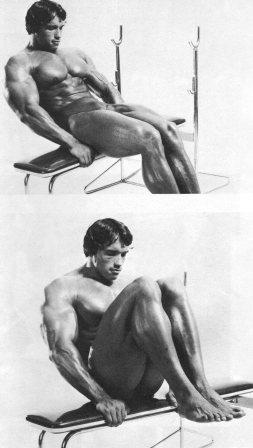 Purpose of the exercise: Development of the upper and lower abdominal press.
Purpose of the exercise: Development of the upper and lower abdominal press.
Performance: In all exercises for the abdominal press, the thorax approaches the pelvic region or vice versa; In this exercise, both of these events occur simultaneously. (1) Sit on a bench and grasp its edges for balance. Slightly lift your legs, bend them at your knees and bend back at an angle of about 45 °. (2) Counter-movement (this exercise is sometimes called "torso bend" with scissors ") bend the trunk forward, arching your back, and simultaneously pull your knees up to your chin. Feel contraction of the abdominal muscles when the chest and pelvic area converge. Then go back to the starting position.
TURBINGS IN SITUATION POSITION
 Purpose of the exercise:
Purpose of the exercise:
Performance: (1) Sit at the end of the bench, resting your feet on the floor and slightly spreading your legs. Put on a stick from a broom or light metal rod and grasp its ends. (2) Keep your head still, turn the body sideways as far as you can. For a second, stay at the extreme point of the movement, then turn the body in the other direction. The movement should be smooth, without jerking and swaying. Since this exercise shortens the oblique abdominal muscles, but is performed without burdening, it compresses the muscles, but does not increase their volume, which can visually widen the waist.
TILT INCLINATION WITH TURNING TURNING
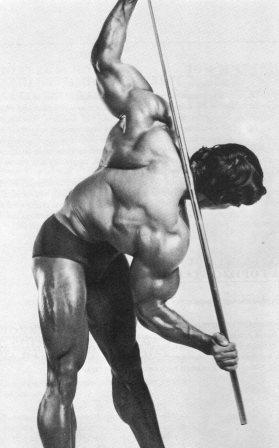 Purpose of the exercise: Condensation of oblique abdominal muscles.
Purpose of the exercise: Condensation of oblique abdominal muscles.
Performance: (1) Stand up with your legs slightly apart, place a broom stick or light metal rod on your shoulders and grasp its ends. Then lean forward from the waist. (2) While keeping your head still and not rotating the pelvis, turn the body sideways as far as you can. Hold for a second at the extreme point of the movement, then turn the torso to the other side. The movement should be smooth, without jerking and swaying.
REVERSIBLE TORSIONS ON THE INCLINED BENCH
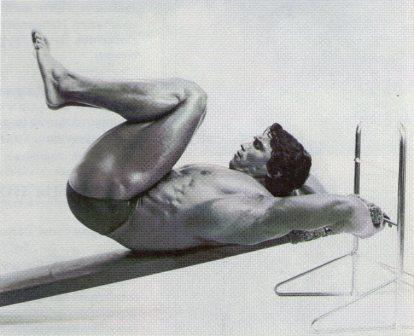 Purpose of the exercise: Development of the lower abdominal press.
Purpose of the exercise: Development of the lower abdominal press.
Performance: (1) Lie on your back on an incline bench so that your head is above your legs. Pull out your hands and grasp the upper edge of the bench for balance. (2) Raise your legs with your knees bent as far as you can, then lower them, stopping at the moment when the coccyx touches the bench. Take a breath while lifting and exhaling while lowering your legs.
LIFTING OF LEGS ON THE HORIZONTAL BENCH
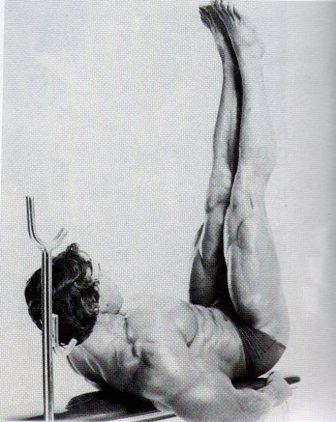 Purpose of the exercise: Development of the lower abdominal press.
Purpose of the exercise: Development of the lower abdominal press.
Performance: (1) Lie on your back on a flat bench so that your buttocks are at the very edge of the bench. Grasp the edge for balance and pull your legs forward. (2) While holding your legs in a straightened position, raise them vertically. Pause, then lower your legs just below the bench level.
LIFTING OF LEGS IN VICE ON PERCEPTION
 Purpose of the exercise: Development of the lower abdominal press.
Purpose of the exercise: Development of the lower abdominal press.
Performance: (1) Grasp the bar of the turnstile and hang on your outstretched arms. (2) While holding your legs in a straightened position, raise them as high as you can. Hold for a second at the top of the movement, then smoothly return to the starting position. Straightened legs increase the load on the abdominal muscles, which makes the exercise more difficult.
LIFTING OF LEGS ON PERCHLAND WITH TURBING TURN
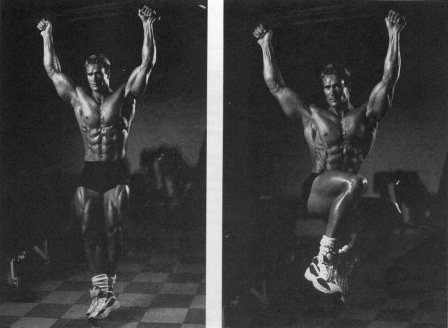 Purpose of the exercise: For oblique muscles of the abdomen and relief of the lateral part of the torso.
Purpose of the exercise: For oblique muscles of the abdomen and relief of the lateral part of the torso.
Performance: Take the starting position for lifting the legs on the crossbar, hanging on the right hands and keeping the legs in the straightened position. Then lift the legs, bending them in the knees, and at the same time lightly turn the torso to the side to engage the oblique abdominal muscles, intercostals and jagged muscles. Hold for a second at the extreme point of movement, then slowly return to the starting position.
Lifting the hull to the forged feet on the side
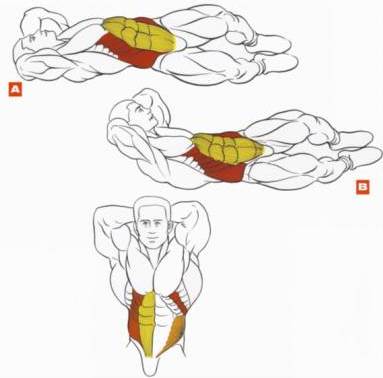 Purpose of the exercise:Development of oblique abdominal muscles.
Purpose of the exercise:Development of oblique abdominal muscles.
Performance: (1) Lying on your back, bend your knees and put them to the right. Put your hands behind your head, relax your neck. (2) Using the left oblique abdominal muscles, tear off the scapula from the floor and lift the thorax towards the pelvis. Hold for a second. Then slowly and gently return your shoulders to their original position. Once your shoulder blades touch the floor, repeat the exercise. When you perform the required number of repetitions on the left side, change the position and work out the right side. Perform on the right side the same number of repetitions as on the left.
SIDE LIFTING LEGS
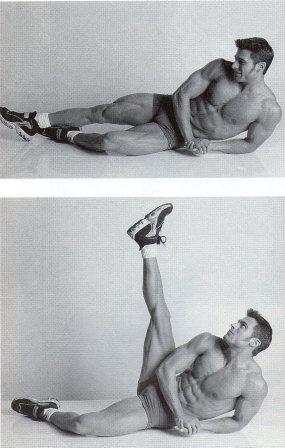 Purpose of the exercise: For oblique abdominal muscles and intercostal muscles. This exercise develops the lateral side of the trunk and visually reduces your waist.
Purpose of the exercise: For oblique abdominal muscles and intercostal muscles. This exercise develops the lateral side of the trunk and visually reduces your waist.
Performance: (1) Lie on your side and lean on your elbow, slightly bending the lower leg in the knee. (2) While holding your upper leg in the straightened position, slowly raise it as high as you can, then lower it, but do not touch the floor. When you have finished moving with one foot, turn to the other side and repeat the exercise.
Makhi Nogami on the side
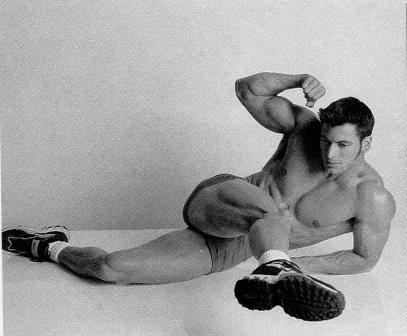 Purpose of the exercise: For oblique muscles of the abdomen and intercostal muscles.
Purpose of the exercise: For oblique muscles of the abdomen and intercostal muscles.
Performance: This exercise begins with the starting position for the lateral lifts of the legs. However, here you slowly lead the upper leg forward as far as possible. The leg should remain straight from the beginning to the end of the movement. After completing the exercise, turn to the other side and work the other foot.
TIGHTENING OF THE ANIMAL ("VACUUM")
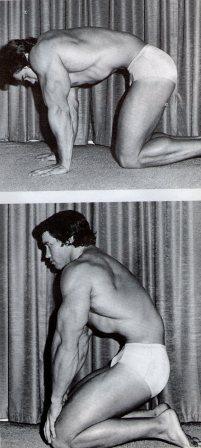 Purpose of the exercise: development of the ability to fully control the muscles of the abdominal press, as well as the development of their relief.
Purpose of the exercise: development of the ability to fully control the muscles of the abdominal press, as well as the development of their relief.
Performance: To fulfill the "vacuum", stand on all fours, exhale all the air from the lungs and draw in the belly as much as you can. Hold this state for 20-30 seconds, then relax for a few seconds and try again two or three times.
The next step is to practice the "vacuum" while kneeling. Straighten, with your hands on your knees, and try to hold the "vacuum" for as long as you can.
The implementation of the "vacuum" in the sitting position is an even more difficult task. But as soon as you learn how to keep the "vacuum" sitting without any problems, you will be able to do this in standing position while performing various poses.
Best Exercises
The muscles of the press are responsible for flexing the trunk forward and to the sides.
Exercises on the press can be divided into the following groups:
Muscles of the press consist of a straight muscle and oblique muscles. The straight muscle is responsible for approaching the pelvis to the chest (twisting). The oblique muscles are responsible for the slopes to the sides.Upper and lower press. Note that in anatomical terms, there are no separate muscles of the upper and lower press. There is one mouse - the rectus abdominis muscle. She is responsible for bringing the pelvis to the chest. However, in the lexicon of bodybuilders you can often find "lower and upper press". This is due to the fact that, depending on the trajectory of motion, you can load different sections of the rectus muscle.
There is an erroneous opinion that the muscles of the press grow with numerous repetitions. In fact, the muscles of the press in terms of development, do not differ from other skeletal muscles. Therefore, in order to pump up the press, the classic bodybuilding technique is suitable.
"How to pump up the press?" - this is one of the most asked questions to coaches in sports halls. Beautiful and embossed press want both men and women. What do you need to do to see the coveted cubes in your press? To begin with, you need to understand that the appearance of the rectus abdominis muscle largely depends on the anatomy, much more than other muscles. In this regard, he may be second only to the calves. You probably noticed that someone can see 6 cubes, someone has 8, some have symmetric cubes, others have symmetry broken or an odd number of press cubes are seen. No exercise can change what is given by nature. But this does not mean that the press should not develop muscle.
Skew muscles of the press. Developed oblique muscles of the press favorably isolate the rectus abdominis and add relief, but often visually make the waist wider. Therefore, exercises on oblique abdominal muscles are often recommended for men. At all it is not necessary to refuse exercises on this department of muscles of a stomach as it as can lead to disproportion. It is best to consult a trainer, he will better pick up a program for you, given your current form, coaching, goals and other individual factors.
Torso elevations on a vertical bench.
This exercise is excellently suited for the development of not only the direct muscle of the press, but also the oblique muscles of the abdomen.
Torso elevations on an incline bench
This exercise is aimed at working out the straight muscle of the press, and especially its upper section.
Crunches with legs on the bench
This exercise allows you to load the rectus abdominis muscle. The greatest load falls on its upper part.
A tight belly with relief "cubes" decorates the figure, making it aesthetic and close in outline to the figure of athletes of ancient Greece. In addition, a pumped up abdominal press is evidence that its owner or possessor has dedicated to the upbringing of his body for more than a day. The tight muscles of the press allow you to have a healthy spine and a beautiful posture. It is not as easy to pump a press as it might seem at first. The secret is that the press has a rather complex structure, and its strengthening should take place in several directions.
Abdominal muscles
The abdominal press consists of four muscle groups:
- the rectus muscle is a long, flat muscle, divided vertically into two parts by a line of tendons. The appointment of the straight muscle of the press - to help keep the back straight, and also tilt the body forward. Horizontally it is crossed by connecting fibers, resulting in the formation of six zones, which, when inflated, transform into all known six "cubes" of the press;
- the transverse muscle of the press - supports the internal organs and is located inside the peritoneum under a straight muscle;
- external oblique muscles of the press - large, well-noticeable muscles, passing diagonally from the chest to the bottom of the abdomen. Skew muscles participate in the processes of bending and turning the body;
- the internal oblique muscles of the press are almost invisible, since they are located in the depth of the abdomen under the external oblique muscles.
It is clear that exercises for the abdominal press are focused, first of all, on the strengthening of the rectus muscle, as well as the oblique external muscle of the abdomen, which gives them the desired relief. But all efforts can be reduced to zero, if not previously to get rid of the fat layer on the abdomen. Practice confirms that if there is a layer of fat on the stomach more than 1 centimeter, you will not be able to achieve the desired relief. Therefore, the first step on the way to a pumped up abdominal press is a set of measures to get rid of fat, or, as the professionals say, "drying out".
It is a mistake to consider what can be eliminated by straining the muscles located on it. Fat burning is most effectively promoted by energy-consuming aerobic exercise and lifting of weights. To achieve the result, it is necessary to make at least 20 approaches. It is worth recalling the need to correct their nutrition.
The second step is the actual growth of the mass of the rectus muscle. To achieve this goal, special exercises are used, which can be divided into basic exercises (aimed at building muscle mass on the abdomen) and additional (shaping the relief). Despite the variety of exercises for the abdominal press, at the heart of all of them lies a single movement - pulling the pelvis to the chest or pulling the chest to the pelvis. This is the only way to activate the muscles of the press. To demonstrate a noticeable result and to strengthen the abdominal press, each exercise is recommended to perform three to four approaches 10-25 times.
Exercises for the abdominal
Twists are recognized as the most effective and at the same time accessible among exercises for pumping the abdominal press. Performing twisting, lying on the floor on the back, you need to put your hands behind your head, bend your knees, resting your feet on the floor. On inhalation, raise the head and shoulders as high as possible, while trying not to tear the lower back from the floor. The back should be rounded. Hold the pause, return to the starting position. Twisting can be complicated: perform them with raised legs, with arms outstretched or with additional weights.
"Bicycle" is an exercise for the abdominal press, familiar to everyone from childhood, but not everyone can do it right. You need to lie on your back, raise your legs, bent at your knees, and twist your imaginary "pedals."
Straight abdominal muscle: long paired muscle stretching from the cartilage of 5-7 ribs and the xiphoid process to the pubic bone. Beams of muscle fibers are interrupted by 3-4 transverse tendon ligaments.
Primary function: strains the spine and tilts the torso, bringing the sternum together with the pelvic region.
Outer oblique abdominal muscles located on both sides of the trunk and attached to the lower eight ribs and the front lateral surface of the chest.
Primary function: strain and rotate the spine.
Intercostal muscles: two thin layers of muscle and tendon fibers occupying the spaces between the ribs.
Primary function: Raise the ribs and bring them closer together with the movement of the trunk.
Muhammad Maccavi
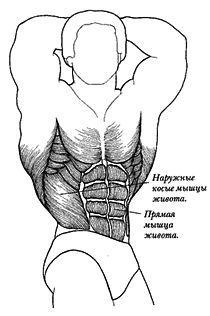
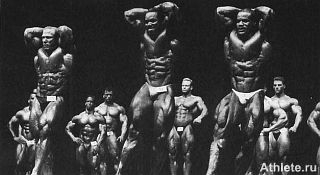
Mike Francois, Flex Wheeler and Chris Cormier demonstrate the mandatory position for the abdominal press in the IFAC competitions: hands behind the head, muscles are tense, one leg is set forward.
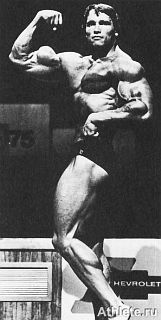
The relief muscles of the abdominal press are important, as is the narrow waist, which makes certain poses, like this demonstration of the biceps with a torso rotation, much more effective.
TRAINING MUSCLES OF ABDOMINAL PRESS
Strong abdominal muscles are necessary for good performances in almost all sports. In bodybuilding, abdominal muscles play an extremely important role, being one of the main elements of the overall impression that your muscles produce on judges and spectators. In fact, they are the visual center of the body. If you put an oblique cross (X) on the body, whose ends are the shoulders and legs, then the lines will cross in the abdominal area, and this place inevitably becomes the center of attention. Men are prone to a disproportionate accumulation of fatty deposits in the abdomen compared to women (which can often be quite complete and yet have clearly marked abdominal muscles), so the clear and prominent abdominal muscles are one of the signs of a good sportive shape.
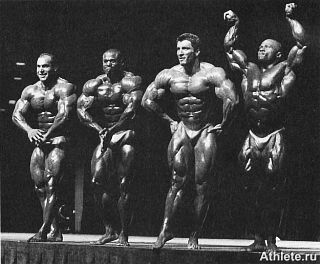
During posing, when you can freely choose poses, do not copy the poses of other participants who have an advantage as a result of the excellent development of certain muscles or at the expense of a larger mass. Nasser el-Sonbati, Vince Taylor, Milos Sarcev and John Sherman.
A bodybuilder gains points at competitions if he has broad shoulders and powerful lateral muscles of the back, tapering to a narrow, dense waist. A narrow waist makes your chest and hips look larger and more impressive, giving them a more aesthetic look.
The traditional V-shape of the trunk is more important than massiveness when it comes to creating a quality, champion body. I often saw how in competitions many good bodybuilders gained a few pounds of extra weight to appear more massive, but it was the extra weight in the waistline that spoiled the visual effect. When I came to bodybuilding, there were few bodybuilders who compensated for the lack of massiveness and size with the outstanding development of abdominal muscles - for example, such sportsmen as Pierre van der Steen and Vince Gironde. But in modern bodybuilding, every future champion, regardless of the type of his physique, must have a well-developed abdominal press to participate in competitions. This applies equally to very massive and high bodybuilders (Dorian Yates, Nasser el-Sonbati, Paul Dillett), middle (Flex Wheeler), short (Shaun Ray) and short (Lee Priest).
If my waist was narrow and tight, with clearly protruding straight and oblique abdominal muscles, when I came to competitions in the US in 1968, I might not give way to Frank Zane. But on the other hand, if Frank came to London for the competition "Mr. Olympia" in the same form as he was in 1979, when he beat Mike Mentzer in a duel for the title of champion, then he could well have the upper hand over Chris Dickerson Instead of taking second place. Frank really became more massive, but lost that incredible relief of the muscles of the abdominal press, which produced such a strong impression in his best days. Inadequate development of the abdominal press or inability to properly show it can be very expensive at competitions. Boyer Koe achieved great success in the 60s and 70s, but he was one of the few leading bodybuilders who could not boast of an excellent "package" of abdominal muscles. This deficiency was inherent and was not explained by improper training, but rivalry has escalated to such an extent that it is now impossible to imagine a bodybuilding champion who does not have excellent abdominal muscles at almost any level of competition. Today, athletes often have problems due to the fact that their abdominal muscles are too massive and the middle of the trunk looks tense. Often this happens as a result of intensive training with heavy burdens (for example, squats with a heavy barbell), and this requires a significant involvement of abdominal muscles and oblique abdominal muscles that act as stabilizers. Therefore now you practically can not meet bodybuilders who use weights for training straight or oblique abdominal muscles. Of course, there are some exercises for the abdominal press that require more effort than overcoming the weight of your own body, but we will discuss this in more detail in the following sections.

The 1980 Olympia position clearly demonstrates that leading bodybuilders must have excellent abdominal muscles to withstand tough rivalry on the stage. As the highest participant, it was especially important for me to have an abdominal press that can withstand muscle comparison Mike Mentzer, Frank Zane and Chris Dickerson.
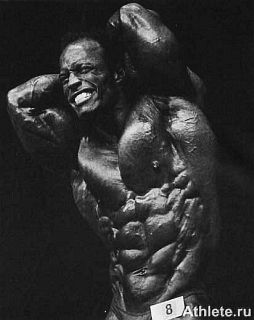
Shawn Ray
When Bill Pearl won at his first competitions in the early 1950s, the outstanding development of abdominal muscles was not absolutely necessary. However, by the time he won the title "Mr. Universe", his abdominal press looked fantastic, despite the fact that his body weight increased.
POINT REDUCTION
Since most modern bodybuilders, despite their height and physique, have a massive development in comparison with body size, the most important goal in abdominal training was relief. For this, two things are necessary: intensive training and minimizing subcutaneous fat, in order to better designate the underlying muscular structure.
When I came to bodybuilding, most of the participants in the competition believed in the so-called principle of point reduction, and now many consider it to be correct. Spot reduction means training specific muscles to "burn" fat in a given area of the body. According to this principle, in order to develop the relief of the muscles of the abdominal press, you are engaged in intensive training with many repetitions and burn fat that covers the abdominal muscles.
Unfortunately, this does not work. When the body experiences a calorie deficit and begins to process fat into energy, this process does not necessarily occur where the muscles perform a significant amount of work, and need additional energy resources. The body has a genetic program that determines access to fat cells, where energy stores are stored. Of course, the exercises burn calories, but the muscles of the abdominal press are so small compared to the rest of the body that, regardless of the volume of their training, you do not include in your metabolism even the amount of fat cells that you could spend if you just strolled for the same time .
However, this does not mean that training the abdominal muscles does not increase their relief. As I have already said, in exercises with a high weight, the abdominal muscles are subjected to intensive loads, but they do not receive a quality training, that is, that insulation, which is achieved with a full range of motion. Exercises with a full range help to reveal the shape and isolation of the abdominal muscles, instead of making them bigger and more massive.
To summarize, although the training of the abdominal muscles does not lead to a significant reduction in body fat around the waist, it creates well-molded muscles that appear when you drive off excess fat with diet and aerobic exercise.
EXERCISES FOR ABDOMINAL PRESS
When the abdominal muscles contract, a very simple thing happens: they pull the chest and pelvic area towards each other with a short, "squeezing" motion. This is what happens in all exercises for the abdominal press. In the past, even before the physiology of exercises for the abdominal press was well studied, bodybuilders performed a large volume of traditional exercises such as lifting the legs and lifting the trunk from a prone position. Unfortunately, these exercises develop more ileum-lumbar muscles, which are sometimes called "thigh stents". These muscles start from the lumbar region, pass over the pelvis and extend to the upper part of the thigh. When you lift your leg, you use the ilio-lumbar muscle. When you get your feet under the pedestal and lift the trunk, as with the usual rise from the floor, you also use these muscles.
Try an experiment. Stand up, grasp your hand for something to balance, and lift one leg in front of you, placing the other hand on your stomach. You will feel tension in the upper part of the thigh, but it becomes clear that the muscles of the abdominal press do not participate in lifting the leg. These muscles are attached to the pelvic area, and not to the leg, so they have nothing to do with raising their legs.
The same happens when the trunk is raised from a prone position or on an inclined bench. In fact, this exercise is the opposite of lifting the legs: instead of keeping the trunk motionless and lifting your legs, you keep your legs still and lift the trunk, using the same ilio-lumbar muscles. In these exercises, abdominal muscles play a predominantly stabilizing role. They keep the trunk straight and still. But this is not at all what you want to achieve when training the muscles of the abdominal press, since their role, as I have already pointed out, is the convergence of the chest and pelvic region - in their reduction by a very short movement, in which the back bends forward. During the rise of the trunk, the back does not bend too much, in contrast to the bending and twisting movements of the trunk. This is the secret of full-scale, quality insulating abdominal muscles training.

This photo was taken one week before the "Mr. Olympia" competition in 1980; you can see how clear and relief the muscles of my abdominals were.
ALL-AVAILABLE FLEXIBILITY
In all exercises aimed at the development of the abdominal press, bending movements are somehow present. You can bring the chest to the pelvic area (usual flexion), bring the pelvic region closer to the chest (back flexion), or pull the pelvis and chest to each other with a "squeezing" movement (grouping). You can perform back bends on a horizontal bench, an incline bench or on a crossbar. But in all these cases, the physiology of the exercise remains the same: the abdominal muscles contract completely (although their range of motion is limited), the pelvic region converges with the sternum, and the spine arching outward.
EXERCISES FOR LUMINOUS MUSCLES OF ANIMAL
The oblique abdominal muscles located along the sides of the trunk perform mainly a stabilizing role. In the gymnasium, as in everyday life, you do not do many movements related to slopes in the sides. Thus, oblique abdominal muscles (like the stabilizing muscles of the lower back) quickly become tired of repeated repetitions and relatively slowly restore their strength.
There was a time when bodybuilders performed many exercises for oblique abdominal muscles, and with quite a lot of burdening. Now it is rare to see professional bodybuilders performing these exercises, as the oblique abdominal muscles increase in size from strength training, visually increasing the waist size and worsening the aesthetic V-shape of the trunk.
Of course, oblique abdominal muscles receive an isometric load each time you squat with a heavy barbell or carry out presses from the shoulders, but since they act only as stabilizers and do not shrink completely, these exercises do not develop them to the same extent as when performing lateral torso of the trunk with dumbbells. Therefore, modern bodybuilders who train oblique abdominal muscles are prone to loose exercises, such as twisting the body or lateral inclinations without burdening that tighten the muscles, but do not make them too massive.
FRONT GEAR AND INTERSECTIONAL MUSCLES
These muscles, located on the side of the upper body, also delight the audience, as well as the muscles of the abdominal press. When you take poses with your hands behind your head and swing your body from side to side to show the relief of these areas - then you can enhance the overall impression of your performance. Again these muscles are developed by flexing and twisting the trunk, only here the shoulder and elbow go down and in, and the body tilts to the side. Try this movement, and you will see how easy it is to feel the tension of the jagged and intercostal muscles. In addition, they develop as a result of a general training program, but you can introduce a specific training for intercostal muscles, adding a twisting element when flexing the trunk.
MAIN TRAINING PROGRAM
Many beginning bodybuilders are enthusiastic about training the hands and chest, ignoring the abdominal muscles. Subsequently, when they start thinking about competitions, they have to expose themselves to extreme stresses in order to "pull up" this part of the body to the rest of the musculature. Therefore, I recommend to train the abdominal muscles from the very beginning; thus, they will develop harmoniously, and you do not have to play catch-up before the competition.
Abdominal muscles need to be developed during each training session. In the main program I recommend alternating normal and reverse bendings of the trunk. Both these exercises develop the abdominal press as a whole, but the usual flexion loads the upper section more, while the back flexes create an additional load on the lower part.
Drawing in the abdomen and tension of the abdominal muscles, when you are engaged in daily activities, is also a good way to strengthen and control this part of the body. You must immediately decide whether the abdominal muscles are the likely weak point in your physique to take the appropriate steps when switching to an intensive training program.
INTENSIVE TRAINING PROGRAM
Continuing to develop the muscles of the abdominal press, you begin to train individual sites, each of which contributes to the formation of dense and relief muscles of the abdomen and the lateral part of the trunk. This implies an increase in the number of series and the emergence of new exercises, such as flexion with torsion, grouping and various types of back flexion.
In the second level program, I recommend starting a workout with a warm-up on the Roman bench - one of my favorite exercises for flexing the torso. As for the oblique muscles of the abdomen, in addition to twisting movements, you will find exercises such as lateral inclinations and inclinations with a turn of the trunk.
THE PREPARATION PROGRAM FOR COMPETITIONS
When you go to the competition level, your goal is to work out the clarity and bumpiness of all the abdominal muscles, and not to increase their size and strength. To increase the intensity of the workout, start with a 10-minute warm-up on the Roman bench. Such warm-up always allowed me to achieve good results, as well as my contemporaries - Franco Colombo, Sabo Kozhevsky and Ken Waller. Exercises on Roman benches warm the muscles and create a prolonged stress, causing the abdominal press to work from the beginning to the end of the movement.
The final product of the preparation program for competitions is the development of all muscles, and each of the exercises described below is intended to strengthen and form a separate part of your torso. To create an abdominal press that will really impress the judges, you need to do exercises for the upper and lower parts of the rectus muscles, oblique and intercostal muscles, and also develop the lower back using hyperextensions and other exercises for the lumbar region. You will need tremendous efforts to establish complete control over the muscles. Continue to try, do not stop for a second, and you will achieve the desired result.
TRAINING WEAK PLACES
The muscles of the abdominal press can be your weak point just like any other part of the body. To correct the deficiencies, I have included in the training program exercises designed to work with any areas that can cause you concern. Although most abdominal exercises have a complex effect on the muscles of the trunk, certain movements are better suited for individual areas - for example, the length of the upper or lower abdominal muscles, oblique abdominal muscles, anterior cog muscle or intercostal muscles. However, keep in mind that the inadequate development of the abdominal press is often caused by the following reasons:
Not enough strict diet, leaving a layer of fat over the abdominal muscles;
Insufficient quality training (without proper isolation and full range of motion).
Training for the sake of quality, you do not cut the abdominal muscles with the lifts of the legs or trunk (these exercises are more for the ilio-lumbar muscles) and do not make sharp, short movements. Qualitative training implies slow, fully controlled movements with a delay at the time of complete muscle contraction.
Serge Nybre

Shawn Ray

Milos Sarcev
When you have a really outstanding development of the abdominal press, the rectus abdominal muscles look relief, regardless of whether you are standing in a relaxed position or straining them, as shown in this photo.
Exercises for the abdominal
BENDING THE TOOL IN THE ROME BENCH
Purpose of the exercise: Accents the load on the upper rectus abdominal muscles.
Performance: (1) Sit on the Roman bench, get your feet under the prop and fold your arms in front of you. (2) While holding the belly retracted, descend at an angle of approximately 70 °, but not parallel to the floor. Rise to the starting position and bend the trunk forward as far as possible, feeling the contraction of the rectus abdominis muscles.
I like to lift the front of the Roman bench to create a tilt and increase the intensity of the exercise. This exercise can also be performed with variable resistance, if you start on an elevated bench, and then, when you start to get tired, lower it to the floor and continue the series.
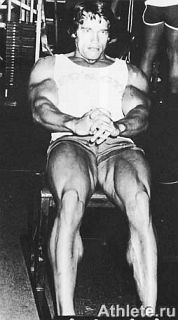
FOLDING OF BUCKLE
Purpose of the exercise: Development of the upper section of the rectus abdominis muscles.
Performance: (1) Lay your back on the floor and put your feet on the bench in front of you, bending them in your lap. You can lay your hands behind your head or hold them in front of your body, as convenient. (2) Bend the trunk towards the knees, arching his back. Do not try to tear the entire back off the floor, just lean forward and bring the chest to the pelvic area. At the top of the movement, specifically tighten the abdominal muscles to achieve a complete contraction, then relax and lower to the starting position. This movement should be carried out slowly, under full control.
You can change the angle of the load on the abdominal muscles, changing the height of the bench. Instead of a bench, try to rest your feet on the wall at any height that you find convenient for yourself.

FLEXIBLE BENDING WITH STRETCHING
Purpose of the exercise: Development of the upper abdominal and oblique muscles of the abdomen.
Performance: (1) Lay your back on the floor and put your feet on the bench in front of you, bending them in your lap. (2) Place your hands behind your head and bend your body toward your knees, arching your back. In this case, bend the trunk sideways, so that your right elbow goes to the left knee. Relax and return to the starting position. Then repeat the motion with a twisting in the opposite direction, so that the left elbow goes to the right knee. Continue to alternate the movement until the end of the series.

TJ Howuben
BULK REVERSE BENDING
Purpose of the exercise:
Performance: This exercise is best performed on a bench for bench presses, with a stand at one end. (1) Lay your back on the bench, pull your hands back and grasp the bar or the edge of the bench for balance. Bend your knees and raise them as high as possible, without tearing the pelvic area and lower back from the bench.

(2) From this position, raise your knees even higher and pull them as close as possible to your face, arching your back and bringing the pelvic area closer to your chest. Hold for a second at the end of the movement and specifically strain the abdominal muscles to achieve their full contraction. Slowly lower your knees until the coccyx touches the bench (do not lower your legs, otherwise the exercise will turn into a kind of lifting of the legs). Repeat this movement slowly and under full control.
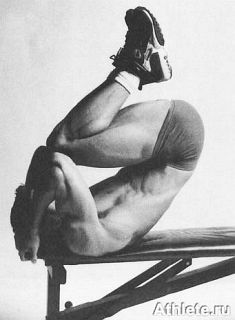
BACK OF THE BULB ON THE PERIODINE
Purpose of the exercise: Development of the lower abdominal press.
Performance: This is another version of the reverse bend of the trunk, only, instead of lying on the bench, you hang on the crossbar. (1) Hang on the crossbar and raise the knees to the level of the abdomen so that the hips are parallel to the floor.
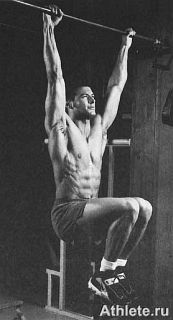
(2) From this position, pull your knees to the chin, arching your back and trying to "roll into the ball." Hold for a second at the top of the movement and as much as possible tighten the abdominal muscles to achieve full contraction, then lower your knees to the starting position, without straightening your legs.
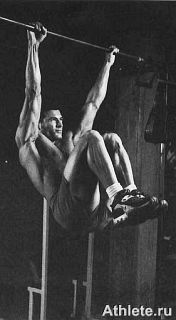
Many ordinary people, most bodybuilders (because of the large mass of the hips) can not correctly perform the back bend of the trunk on the crossbar. There is an easier option when you lie your head up on an incline bench. This creates a greater load than with the reverse bending of the trunk on a horizontal bench, but you can vary it at will by changing the angle of the bench.
GROUPING ON A VERTICAL BENCH
Purpose of the exercise: Development of the lower abdominal press.
Performance: This is a variant of the back bend of the trunk on the crossbar. (1) Instead of the crossbar, sit on a vertical bench with an elbow support and raise the knees to the level of the abdomen so that the hips are parallel to the floor.

(2) From this position, pull your knees up as high as possible to the chin, arching your back and trying to "roll into the ball." At the top of the movement, hold for a second and strain the abdominal muscles to achieve their full contraction. Then lower your legs to their original position, but do not straighten your knees.
![]()
FOLDING OF THE BODY ON THE UPPER BLOCK
Purpose of the exercise: This exercise was used more often in the old days than now, but it is quite effective.
Performance: (1) Attach the rope to the top block. Go down on your knees and grasp the rope with both hands.
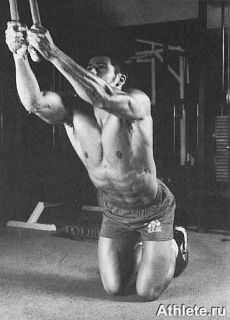
(2) Holding the rope in front of you at the level of your forehead, lean forward, arching your back and bringing your head closer to your knees. Hold for a second at the bottom of the movement to achieve complete contraction of the abdominal muscles, then return to the starting position. Do not pull with your hands; The main load should lie on the abdominal muscles.
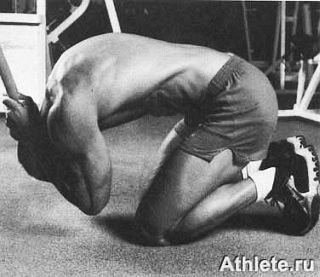
FOLDING THE TOUCH AT THE TRAINER
Purpose of the exercise: Development of the upper and lower abdominal press.
Performance: A significant majority of bodybuilders believe that when training abdominal muscles there is no need for simulators, but others are ready to swear that the simulators are very useful. For example, Charles Glass often offers his clients to use the Nautilus trainer for bending the trunk. In any case, focus on the convergence of the pelvic region and chest, feeling an intensive contraction of the abdominal muscles. If you can not achieve this feeling, then the simulator that you use is not suitable for your individual needs.
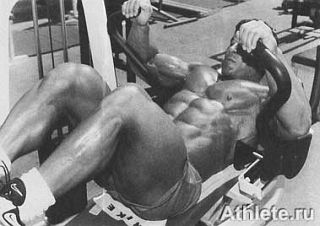
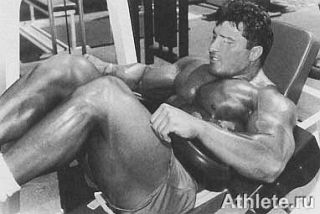
Milos Sarcev

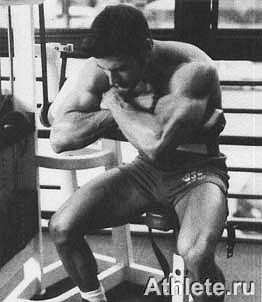
TJ Howuben
GROUPING ON HORIZONTAL BENCH
Purpose of the exercise: Development of the upper and lower abdominal press.
Performance: In all exercises for the abdominal press, the thorax approaches the pelvic region or vice versa; In this exercise, both of these events occur simultaneously. (1) Sit on a bench and grasp its edges for balance. Slightly lift your legs, bend them at your knees and bend back at an angle of about 45 °.
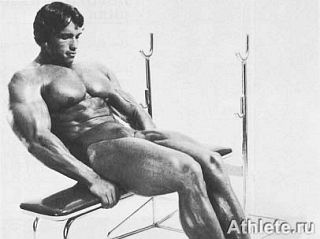
(2) Counter-move (this exercise is sometimes called "torso bend" with scissors ") bend the trunk forward, arching your back, and simultaneously pull your knees up to your chin.Try the contraction of the abdominal muscles when the chest and pelvic area converge, then return to the starting position.
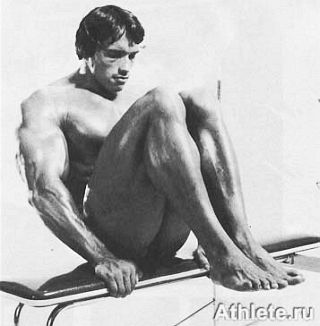
TURBINGS IN SITUATION POSITION
Purpose of the exercise:
Performance: (1) Sit at the end of the bench, resting your feet on the floor and slightly spreading your legs. Put on your shoulders a stick from a broom or a light metal rod and grasp its ends. (2) Keep your head still, turn the body sideways as far as you can. For a second, stay at the extreme point of the movement, then turn the body in the other direction. The movement should be smooth, without jerking and swaying. Since this exercise shortens the oblique abdominal muscles, but is performed without burdening, it compresses the muscles, but does not increase their volume, which can visually widen the waist.
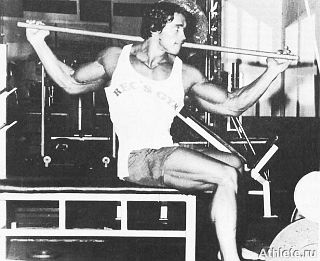
TILT INCLINATION WITH TURNING TURNING
Purpose of the exercise: Condensation of oblique abdominal muscles.
Performance: (1) Stand up with your legs slightly apart, place a broom stick or light metal rod on your shoulders and grasp its ends. Then lean forward from the waist. (2) While keeping your head still and not rotating the pelvis, turn the body sideways as far as you can. Hold for a second at the extreme point of the movement, then turn the torso to the other side. The movement should be smooth, without jerking and swaying.
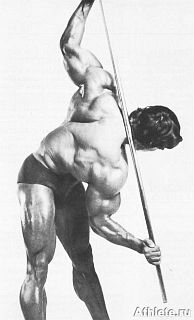
LIFTING LEGS
This is a traditional exercise for the muscles of the abdominal press, which recently is not popular with specialists in physiology. The reason is that the muscles of the abdominal press are not connected with the legs, so lifting and lowering only indirectly affects them (they play a stabilizing role). When lifting the legs, the iliopsoas muscles work, which start from the lower back, pass over the pelvis and are attached to the femur.
Nevertheless, I achieved good results with this exercise, like many other bodybuilders. In my opinion, this encyclopedia will be incomplete if you do not include the options for lifting your legs. I believe specialists in exercise physiology, but in bodybuilding, what's important for you, regardless of expert opinion, is important.
LIFTING OF LEGS ON THE HORIZONTAL BENCH
Purpose of the exercise: Development of the lower abdominal press.
Performance: (1) Lie on your back on a flat bench so that your buttocks are at the very edge of the bench. Grasp the edge for balance and pull your legs forward.
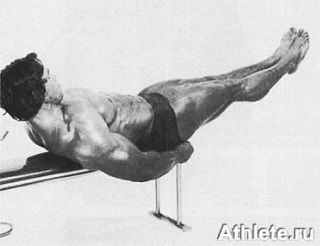
(2) While holding your legs in a straightened position, raise them vertically. Pause, then lower your legs just below the bench level.
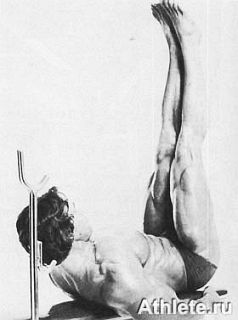
LIFTING LEGS WITH FOLDED KNIVES ON HORIZONTAL BENCH
Purpose of the exercise: Development of the lower abdominal press.
Performance: Lie down on the bench in the starting position for the previous exercise. Bend your knees and raise them as high as possible. Pause at the top of the movement, then lower your legs, keeping them bent.
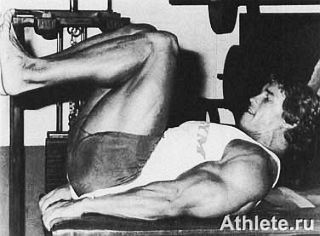
LIFTING OF LEGS WITH FOLDED KNIVES ON THE INCLINED BENCH
Purpose of the exercise: Development of the lower abdominal press.
Performance: (1) Lie on your back on an incline bench so that your head is above your legs. Pull out your hands and grasp the upper edge of the bench for balance. (2) Raise your legs with your knees bent as far as you can, then lower them, stopping at the moment when the coccyx touches the bench. Take a breath while lifting and exhaling while lowering your legs.

LIFTING LEGS WITH FOLDED KNIVES ON THE VERTICAL BENCH
Purpose of the exercise: Development of the lower abdominal press.
Performance: (1) Take the original position on a vertical bench with an emphasis for the elbows and forearms.
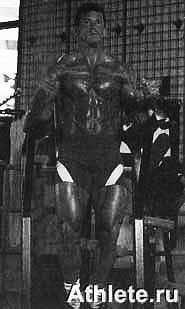
(2) Hold the trunk motionless, bend your knees and raise them as high as you can. Straighten the abdominal muscles throughout the range of motion. Then lower your legs to their original position, without bending your knees.
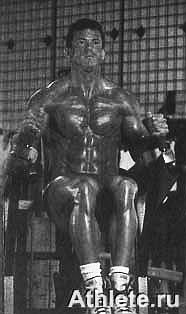
B. J. Quinn
Option: Any exercise option forces the muscles to react in new and unexpected ways. When you are training the abdominal muscles on a vertical bench, try lifting your legs alternately, not simultaneously.
LIFTING OF LEGS ON PERCEPTION
Purpose of the exercise: Development of the lower abdominal press.
Performance: (1) Grasp the bar of the turnstile and hang on your outstretched arms.

(2) While holding your legs in a straightened position, raise them as high as you can. Hold for a second at the top of the movement, then smoothly return to the starting position. Straightened legs increase the load on the abdominal muscles, which makes the exercise more difficult.

Milos Sarcev
LIFTING OF LEGS ON PERCHLAND WITH TURBING TURN
Purpose of the exercise: For oblique muscles of the abdomen and relief of the lateral part of the torso.
Performance: Take the starting position for lifting the legs on the crossbar, hanging on the right hands and keeping the legs in the straightened position. Then lift the legs, bending them in the knees, and at the same time lightly turn the torso to the side to engage the oblique abdominal muscles, intercostals and jagged muscles. Hold for a second at the extreme point of movement, then slowly return to the starting position.
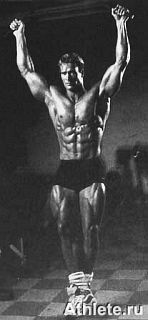
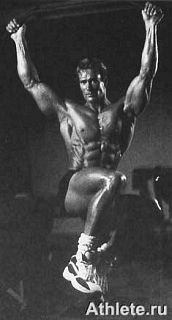
Mike O "Hearn
ADDITIONAL OPTIONS OF LIFTING LEGS
In addition to the basic exercises, there are a number of options for lifting the legs, which I always liked. I believe that they tighten the muscles of the thighs, lower back and gluteal muscles and have a restorative effect. These exercises can be performed with a very large number of repetitions - both in the gym, at home or in the hotel room.
The advantage of these exercises is that they work with the bottom of the body at different angles. In addition, they are useful for a large number of people, from professional bodybuilders and serious athletes to men and women who simply try to maintain a good physical shape.
SIDE LIFTING LEGS
Purpose of the exercise: This exercise develops the lateral side of the trunk and visually reduces your waist in the frontal pose.
Performance: (1) Lie on your side and lean on your elbow, slightly bending the lower leg in the knee.

(2) While holding your upper leg in the straightened position, slowly raise it as high as you can, then lower it, but do not touch the floor. When you have finished moving with one foot, turn to the other side and repeat the exercise.
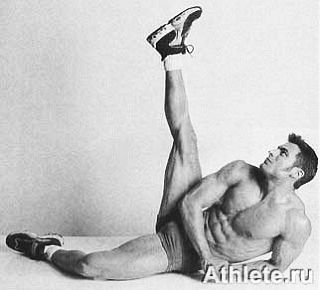
SIDE LIFTS OF LEGS WITH FASTENED KNEES
Purpose of the exercise: For oblique abdominal muscles and intercostal muscles.
Performance: Lie on your side and lean on your elbow, slightly bending the lower leg in the knee. Then bend the upper leg in the knee and slowly raise it towards the breast as high as you can. Return to the starting position without touching the floor. When you have finished moving with one foot, turn to the other side and repeat the exercise.
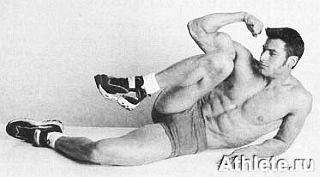
Makhi Nogami on the side
Purpose of the exercise: For oblique abdominal muscles and intercostal muscles.
Performance: This exercise begins with the starting position for the lateral lifts of the legs. However, here you slowly lead the upper leg forward as far as possible. The leg should remain straight from the beginning to the end of the movement. After completing the exercise, turn to the other side and work the other foot.
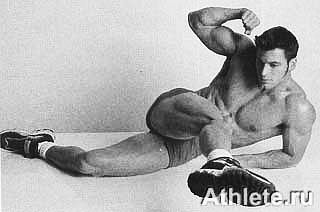
REAR LIFTING LEGS ON THE BENCH
Purpose of the exercise:
Performance: (1) Bend one leg in the knee and grasp the edge of the bench for balance. Do not bend your arms at the elbows.
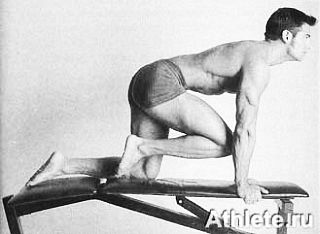
(2) Raise the other leg up and back, then lower it without touching the bench. When moving, focus on the tension of the gluteal muscles. Then change your leg and repeat the exercise. This exercise can be performed on the floor, but then it becomes a bit more complicated.
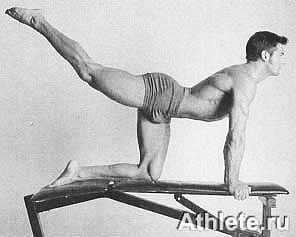
"SCISSORS" ON THE ANIMAL
Purpose of the exercise: For training the gluteal muscles.
Performance: (1) Lie on your stomach and rest your palms on your hips. Tear off the legs from the floor, as far as possible.
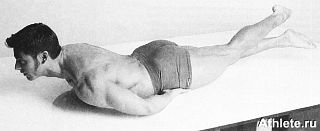
(2) Slightly spread your legs, then cross them one over the other. (3) Spread your legs and cross them again so that the other leg is on top. Continue to alternate the position of the legs until you finish the series. During the whole exercise, focus on the tension of the gluteal muscles.

TIGHTENING OF THE ANIMAL ("VACUUM")
The ability to control the muscles of the abdominal press to the point where you can hold a full "vacuum" during posing becomes a lost art in bodybuilding. This is sad, because the drawn-up stomach not only looks impressive on the stage, visually reducing the waist line and increasing the size and fullness of the chest, but also allows you to develop the relief of the abdominal muscles and constantly monitor them, even in those moments when you are standing in a relaxed pose.
In a tense atmosphere of competition, bodybuilders often forget that they are watched all the time while they are on the stage - even when they are behind and await their turn. You can not give judges even the slightest hint of fatigue, and the ability to keep abdominal muscles under tight control is one way to avoid this.
Nowadays it is sometimes difficult for bodybuilders to fully entangle the abdomen, because the muscles of their abdominals have become very massive. But the main reason is that they are not engaged in regular practice of "vacuum". This art can not be mastered in one hour. Just like any other kind of posing, it requires constant training for weeks or months, until you establish complete control over the muscles.
To fulfill the "vacuum", stand on all fours, exhale all the air from the lungs and draw in the belly as much as you can. Hold this state for 20-30 seconds, then relax for a few seconds and try again two or three times.
The next step is to practice the "vacuum" while kneeling. Straighten, with your hands on your knees, and try to hold the "vacuum" for as long as you can.
The implementation of the "vacuum" in the sitting position is an even more difficult task. But as soon as you learn how to keep the "vacuum" sitting without any problems, you will be able to do this in standing position while performing various poses.
